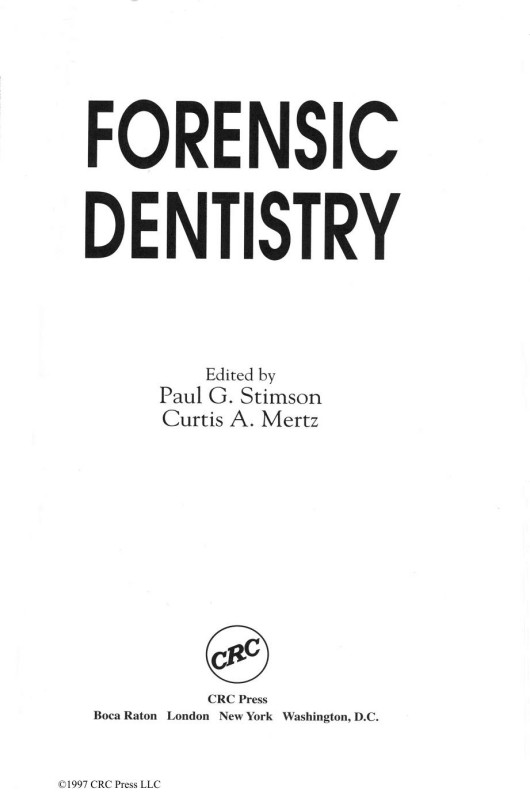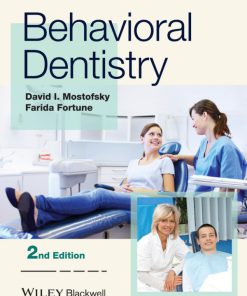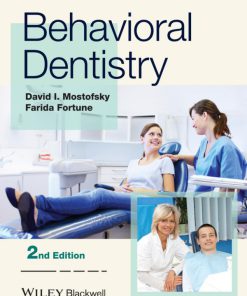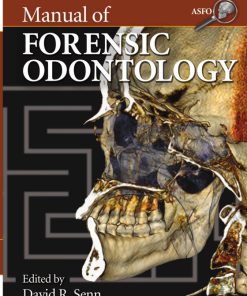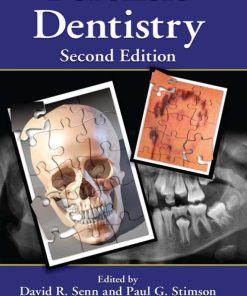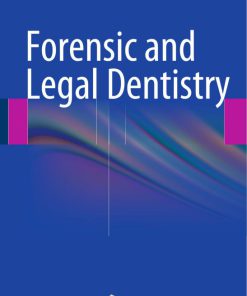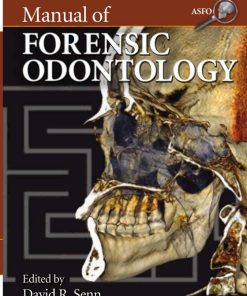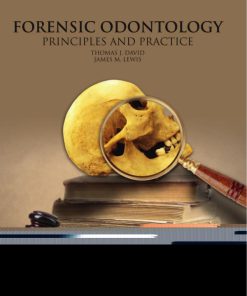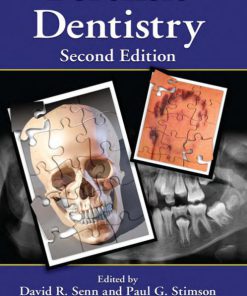Forensic Dentistry 2nd Edition by David Senn,Paul Stimson 9781040085011 1040085016
$50.00 Original price was: $50.00.$25.00Current price is: $25.00.
Authors:Paul G. Stimson; Curtis A. Mertz , Author sort:Stimson, Paul G. & Mertz, Curtis A. , Published:Published:Sep 2005
Forensic Dentistry 2nd Edition by David Senn,Paul Stimson – Ebook PDF Instant Download/Delivery.9781040085011,1040085016
Full download Forensic Dentistry 2nd Edition after payment
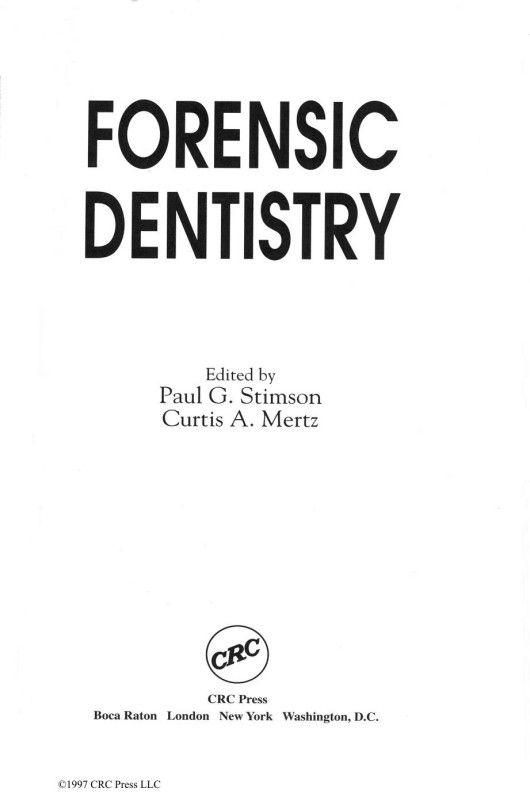
Product details:
ISBN 10:1040085016
ISBN 13:9781040085011
Author: David Senn,Paul Stimson
The identification of unknown individuals and the estimation of age, race, and gender are among the chief functions of forensic dentistry. Other important applications include the investigation and analysis of bitemarks and oral injuries in abuse cases and evaluating, reporting, and testifying in civil litigation cases. Twelve years after the benchmark first edition of this book explored these topics, the long-awaited Forensic Dentistry, Second Edition offers a comprehensive update and revision of the material. Offering insight from many new contributors on the cutting edge of forensic science and odontology, this new edition expands the book’s scope to include a broader historical and theoretical analysis, a thorough assessment of the past decade’s developments, and a far-reaching projection of future trends. New topics in the second edition include: Forensic dental radiography Age estimation Jurisprudence and legal issues History of forensic dentistry Landmark cases, including September 11th and Hurricane Katrina In order for forensic odontology to continue to progress as a specialty of forensic science, there must be a consistent stream of new ideas and original and applied research. Heavily illustrated and enhanced with a 16-page color insert with additional photos, this volume captures the critical issues that confront today’s forensic dentist, explores the field’s limitations, and provides a window on the future of this crucial sector within the forensic identification science arena.
Forensic Dentistry 2nd Table of contents:
1 Science, the Law, and Forensic Identification
1.1 Introduction
1.2 Science
1.3 The Law
1.4 Forensic Identification and Forensic Dentistry
1.5 Conclusion
References
2 History of Forensic Dentistry
2.1 The Garden of Eden
2.2 Aggripina the Younger—Lollia Paulina
2.3 Jai Chand, Last Raja of Kanauji
2.4 The Earl of Shrewsbury
2.5 Charles the Bold, Duke of Burgundy
2.6 Peter Halket
2.7 Dr. Joseph Warren—Paul Revere
2.8 Janet McAlister—Dr. Pattison
2.9 Guerin
2.10 Caroline Walsh
2.11 Louis XVII
2.12 Dr. John Webster—Dr. George Parkman
2.13 William I, the Conqueror
2.14 Misidentification Corrected
2.15 A. I. Robinson—this Mistress
2.16 Winfield Goss—Mr. Udderzook
2.17 John Wilkes Booth, 1865 and Again in 1893
2.18 Dr. Oscar Amoëdo—The Bazar de la Charite, 1898
2.19 Strenuous Cross-Examination, 1898
2.20 Iroquois Theatre—Chicago, 1903
2.21 Bites in Cheese, 1905 and 1906
2.22 Chilean-German Discord Averted, 1911
2.23 Tooth Numbering Systems and Denture Marking
2.24 John Haig—Denture-Aided Identification, England
2.25 Denture Tooth-Aided Identification—Australia
2.26 Facial Reconstruction—Kollman and Buchley, Then Gatliff
2.27 Adolf Hitler
2.28 Texas v. Doyle, Doyle v. Texas, 1954
2.29 Lee Harvey Oswald, 1963 and Again in 1981
2.30 Other Cases
2.31 Summary
References
3 Scope of Forensic Odontology
3.1 Introduction
3.2 Dental Identification
3.3 Multiple Fatality Incident Management
3.4 Bitemark Evidence Collection and Analysis
3.5 Abuse
3.6 Age Estimation
3.7 Expert Testimony in Criminal and Civil Litigation
3.8 Summary
References
4 Death Investigation Systems
4.1 Introduction
4.2 Early Death Investigation
4.3 The Coroner System
4.4 Modren American Death Investigation Systems
4.5 Death Certification
4.5.1 Cause of Death
4.5.2 Manner of Death
4.6 Facets of a Modern Death Investigation Office
4.7 Quality Assurance
4.8 Summary
References
5 Forensic Medicine and Human Identification
5.1 Background
5.2 Human versus Nonhuman
5.3 Establishing Identity
5.4 Visual Identification
5.5 Circumstantial
5.6 External Characteristics
5.7 Internal Characteristics
5.8 Radiographs
5.9 Anthropology
5.10 Sources of Comparison
5.11 Methodology for an Unidentified Person/Body
References
Suggested Reading
6 Fingerprints and Human Identification*
6.1 Introduction
6.2 historical Overview of Fingerprints
6.3 Fingerprint Fundamentals
6.4 Comparison and Identification of Friction Ridge Impressions
6.5 The Postmortem Fingerprint Recovery Process
6.5.1 Inspecting and Cleansing the Friction Skin
6.5.2 Reconditioning Compromised Friction Ridge Skin
6.5.3 Recording Postmortem Impressions
6.6 Automated Fingerprint Identification Technology
6.7 Conclusion
Acknowledgments
References
7 DNA and DNA Evidence*
7.1 Introduction
7.2 Molecular Biology and Inheritance
7.3 Laboratory Processing
7.3.1 Extraction (Isolation of DNA)
7.3.2 Amplification (Quantitation and PCR)
7.3.3 Analysis (Electrophoresis, Detection, and Interpretation)
7.3.4 DNA Laboratory Quality Assurance
7.4 DNA and the Management of Mass Fatality Incidents
7.4.1 Planning
7.4.2 Establishing the Scope
7.4.3 Communicating with the Laboratory
7.4.4 Evidence Collection Teams
7.4.5 Transportation and Storage
7.4.6 Data Management
7.5 Teeth as Sources for Forensic DNA
7.6 Saliva and Oral Mucosa as Sources for Forensic DNA
7.6.1 Salivary DNA in Bitemark Evidence
7.6.2 Oral Mucosal DNA and Buccal Swabs
7.7 DNA Databases
7.7.1 CODIS
7.7.1.1 Convicted Offender Index
7.7.1.2 Convicted Offender Index
Glossary
Acknowledgments
References
Suggested Reading
8 Forensic Anthropology
8.1 Introduction
8.2 Typical Case Progression
8.2.1 Animal vs. Human and Minimum Number of Individuals
8.2.2 Minimum Number of Individuals
8.2.3 Medicolegal Significance of Human Remains
8.2.4 The Biological Profile
8.2.4.1 Sex
8.2.4.2 Ancestry
8.2.4.3 Skeletal and Dental Age
8.2.4.4 Stature and Physique
8.2.5 Individualization
8.2.6 Postmortem Interval
8.2.7 Trauma
8.2.7.1 Antemortem Trauma and Pathology
8.2.7.2 Perimortem Trauma
8.2.7.3 Postmortem Trauma
8.3 Databases
8.4 The Future
References
9 Forensic Dental Identification
9.1 Introduction
9.1.1 Fingerprints
9.1.2 Personal Items
9.1.3 Tattoos and Scars
9.1.4 DNA and DNA Evidence
9.2 History of Dental Identification
9.3 Philosophy and Legal Basis for Dental Identification
9.4 Steps in Dental Identification
9.4.1 Postmortem Examination
9.4.2 Antemortem Examination
9.4.3 Comparison
9.5 Statistical and Mathematical Models
9.6 ABFO Guidelines and Standards
9.7 Technological and Scientific Advances
9.8 Ten Tips and Cautions for Dental Identification
9.9 Summary
References
10 Forensic Dental Radiography
10.1 Introduction
10.2 Dental X-ray Generators
10.3 The Radiographic Image and Image Receptors
10.4 Film Image Processing
10.5 Intraoral Radiographic Techniques
10.6 Biological Effects of X-rays
10.7 Radiation Protection
10.7.1 Maximum Permissible Dose
10.7.2 Personnel Monitoring
10.7.3 Handheld X-ray Devices
10.8 Radiographic Equipment in the Forefront of Forensic Dentistry (CBCT)
10.9 Radiographic Pitfalls and Tips
10.9.1 Skeletal and Carbonized Remains
10.9.2 Issues with Duplicated Radiographs
10.9.3 Jaw Fragments
10.9.4 Panoramic
References
11 Forensic Dental Photography
11.1 Introduction
11.2 The Spectrum of Light
11.3 Properties of Illumination
11.4 Properties of Injured Skin: Inflammation and Repair
11.5 Forensic Dental Photography: Types and Techniques
11.6 Visible Light Photography
11.7 Film-Based Photography
11.8 Digital Photography
11.9 Alternate Light Imaging and Fluorescent Imaging Techniques
11.10 Nonvisible Light Photography
11.10.1 Ultraviolet (UV) Light Sources
11.10.2 Infrared (IR) Light Sources
11.11 Focus Shift
11.12 Reflective Long-Wave Ultraviolet Photography
11.13 Infrared Photography
11.14 Application and Use of Forensic Photography
11.15 Management of Forensic Photographic Evidence
References
12 Dental Identification in Multiple Fatality Incidents
12.1 Introduction
12.2 Multiple Fatality Incident/Mass Disaster
12.3 Types of Multiple Fatality Incidents/Mass Disasters
12.3.1 Natural Disasters
12.3.2 Transportation Accidents
12.3.3 Terrorism
12.3.3.1 Weapons of Mass Destruction
12.4 Disaster Site/Crime Scene Management
12.4.1 Crime Scene
12.4.2 Incident Perimeter
12.4.3 Grid/GPS
12.4.4 Security and Safety
12.5 Interagency Relations
12.6 Identification Section
12.7 Odontology Section
12.8 Computer Assistance Programs and Digital Information
12.9 Digital and Conventional Images
12.10 Preparedness Training and Planning
12.11 Conclusions
References
13 Age Estimation from Oral and Dental Structures
13.1 Introduction
13.2 Tooth Eruption/Tooth Emergence
13.2.1 Statistical Concerns
13.3 Tooth Mineralization
13.3.1 Primary Tooth Formation
13.3.2 Permanent Tooth Formation
13.3.3 Dental Age
13.4 Age Estimates for Adolescents and Adults
13.4.1 Gustafson Method
13.4.2 Root Transparency
13.4.3 Cementum Annulations
13.4.4 Tooth Wear
13.4.5 Third Molar Formation
13.4.6 Aspartic Acid Racemization
13.4.7 Enamel Uptake of Radioactive Carbon-14
13.5 Summary, Conclusions, and Recommendations
References
14 Bitemarks
14.1 Background and History of Bitemarks and Bitemark Cases
14.1.1 Chronology
14.1.1.1 Before the Twentieth Century
14.1.1.2 1692, Salem Witch Trials, Reverend George Burroughs
14.1.1.3 Twentieth Century
14.1.2 Significant Cases
14.1.2.1 Texas v. Doyle, 1954
14.1.2.2 Public Prosecutor v. Torgersen (Norway), 1958
14.1.2.3 Crown v. Hay (Scotland), 1967
14.1.2.4 Illinois v. Johnson, 1972
14.1.2.5 California v. Marx, 1975
14.1.2.6 Illinois v. Milone, 1976
14.1.2.7 Florida v. Bundy, 1979 and Florida v. Bundy, 1980
14.1.2.8 Florida v. Stewart, 1979
14.1.3 Problem Cases
14.1.3.1 Frederik Fasting Torgersen, 1958
14.1.3.2 Richard Milone, 1976
14.1.3.3 Greg Wilhoit, 1987
14.1.3.4 Ray Krone, 1992
14.1.3.5 Michael Cristini and Jeffrey Moldowan—Michigan
14.1.3.6 Kennedy Brewer—Mississippi
14.2 Bitemark Characteristics
14.2.1 Bitemark: Definition
14.2.2 Bitemarks and Teeth Marks
14.2.3 Class Characteristics
14.2.4 Individual Characteristics
14.2.5 Bitemark Frequency and Distribution, and Biter Demographics
14.3 Bitemark Case Management
14.3.1 Evidence Collection
14.3.1.1 Evidence from the Bitemark or Patterned Injury
14.3.1.2 Evidence from Potential or Suspected Biters
14.3.2 Analysis of Evidence
14.3.2.1 Legal Considerations
14.3.2.2 Methods of Analysis
14.3.3 Comparison of Injury and Dental Evidence
14.3.3.1 Methods of Analysis
14.3.3.2 Reporting Conclusions and Opinions
14.4 Scientific Considerations, Bitemark Issues, and Controversies
14.4.1 The Uniqueness of the Human Dentition
14.4.2 Human Skin as a Medium for Recording Bitemark Patterns
14.4.3 Statistical and Mathematical Analyses Relating to Bitemarks
14.4.4 ABFO Bitemark Workshop 4
14.4.5 The Totalitarian Ego
14.5 Forensic Value of Bitemark Evidence
14.6 Responsibilities and Consequences of Forensic Odontology Expert Testimony
14.7 The Future of Bitemark Analysis
References
15 Abuse
15.1 Introduction and Background
15.2 Child Maltreatment
15.3 Abuse during Pregnancy
15.4 Physical Injuries during Dating
15.5 Spouse Abuse (Intimate Partner Violence)
15.6 Elder Abuse
15.7 Conclusion
References
16 Jurisprudence and Legal Issues
16.1 Legal Overview
16.1.1 Introduction
16.1.2 The American Legal System
16.1.2.1 Criminal Litigation
16.1.2.2 Civil Litigation
16.1.3 Court Systems
16.1.3.1 State Courts
16.1.3.2 Federal Courts
16.1.3.3 The U.S. Constitution
16.1.4 Court Decision Reporting Systems
16.2 Forensic Dentists and Criminal Litigation
16.2.1 Expert Witnesses
16.3 Forensic Dentists and Civil Litigation
16.3.1 The Civil Litigation Process
16.3.1.1 Dentists as Defendants
16.3.1.2 Dentists as Fact Witnesses
16.3.1.3 Dentists as Expert Witnesses
16.3.2 Standard of Care Litigation (Malpractice)
16.3.3 Personal Injury Litigation
16.3.4 Dentists as Expert Witness Defendants
16.4 Case Law
16.5 Conclusion
References
17 Evidence Management
17.1 Introduction
17.2 Preparation
17.3 Approach the Scene
17.4 Secure and Protect the Scene
17.5 Initiate a Preliminary Survey
17.6 Evaluate the Odontological Evidence Possibilities
17.7 Prepare a Narrative Description
17.8 Depict the Scene Photographically
17.8.1 Photography Basics
17.9 Prepare a Diagram/Sketch
17.10 Conduct a Detailed Search for Forensic Dental Evidence
17.11 Record and Collect the Odontological Evidence
17.12 Conduct a Final Survey
17.13 Release the Scene
17.14 Summary
18 Future of Forensic Dentistry
18.1 A Look to the Past
18.2 Research and Technology
18.3 Certifying Organizations and Certification
18.4 The Way Forward
People also search for Forensic Dentistry 2nd:
who is credited with establishing the science of forensic dentistry
what was the earliest example of forensic dentistry
what is done to identify the victim in forensic dentistry
forensic dentistry salary
forensic dentistry and odontology
You may also like…
eBook PDF
Behavioral Dentistry 2nd edition by David Mostofsky, Farida Fortune ISBN 1118272064 9781118272060
eBook PDF
Behavioral Dentistry 2nd edition by David Mostofsky, Farida Fortune ISBN 1118272064 978-1118272060
eBook PDF
Manual of Forensic Odontology 5th Edition by David Greene,David Williams 9781040081389 104008138X
eBook PDF
Evidence Based Forensic Dentistry 1st edition by Jasdeep Kaur,Balwant Rai 9783642289941 3642289940
eBook PDF
Manual of Forensic Odontology 5th Edition by David Williams,David Greene 9781040081389 104008138X

